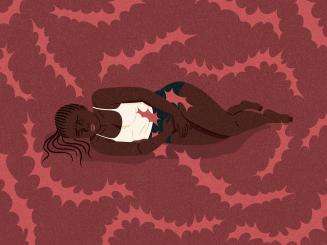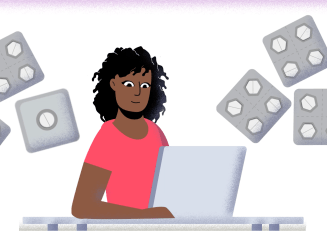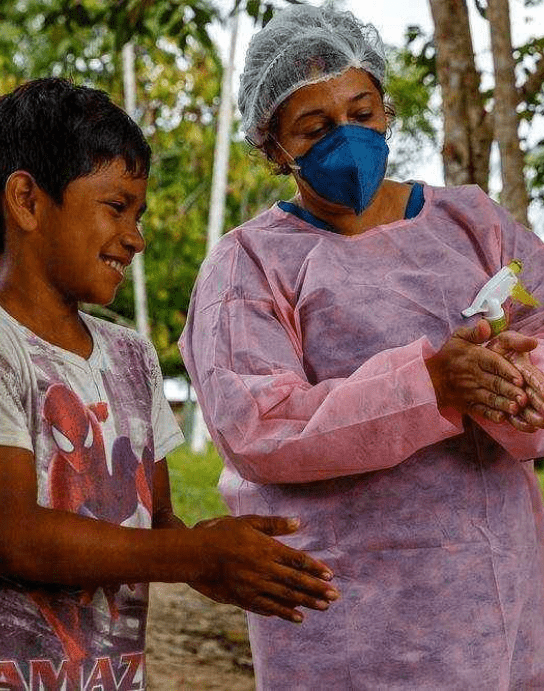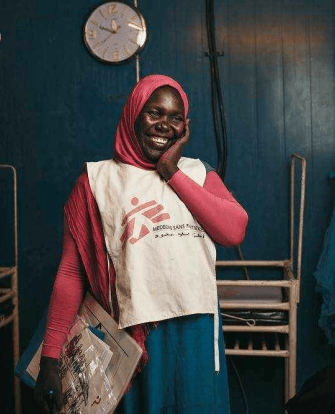
Mozambique 2023 © Miora Rajaonary
Safe abortion
Safe abortion is essential health care and a critical part of comprehensive reproductive care. When people do not have access to safe abortion, the health consequences can be devastating or even fatal.
Putting safe abortion in context
Access to safe abortion is a critical aspect of women's health and reproductive health around the world. Although there have been major decreases in most leading causes of maternal deaths worldwide over the past two decades, one glaring exception remains: Unsafe abortion, which causes an estimated 29,000 deaths each year and millions of serious complications. Since MSF projects often see patients suffering from the severe, potentially life-threatening effects of unsafe abortion, we have expanded our efforts to help people access safe abortion care and to find ways of providing it at our projects.unintended pregnancies worldwide end in induced abortion
induced abortions occur around the world each year
of abortions that take place in the world are unsafe, the majority in developing countries
Facts about safe abortion access
Abortion occurs when a pregnancy is ended. It can happen spontaneously, also referred to as miscarriage, or as the result of a deliberate intervention.
Abortion occurs when a pregnancy is ended. It can happen spontaneously, also referred to as miscarriage, or as the result of a deliberate intervention.
An abortion is considered safe if it’s carried out by a trained professional using a method recommended by the World Health Organization (WHO) and appropriate to the pregnancy duration.
An abortion is considered safe if it’s carried out by a trained professional using a method recommended by the World Health Organization (WHO) and appropriate to the pregnancy duration. If any of these conditions is not met, the abortion is unsafe.
Unsafe abortions are mainly categorized categories for unsafe abortions areas “less safe” and or “least safe.”
Unsafe abortions are mainly categorized categories for unsafe abortions areas “less safe” and or “least safe.” “Less safe” abortions involve either an outdated, unsafe method or a lack of access to proper information; “least safe” abortions involve both. Examples we see in our projects include inserting sharp sticks or needles into the uterus; ingesting harmful substances such as bleach, battery acid, or chlorine; using external force on the abdomen; and using medications incorrectly and without appropriate support.
Safe abortion care can be provided either with medications or with an outpatient procedure.
Safe abortion care can be provided either with medications or with an outpatient procedure.
Medication abortion, meaning an abortion with pills, involves two drugs: mifepristone and misoprostol. Mifepristone blocks progesterone, one of the main hormones of pregnancy, while misoprostol causes the uterus to contract and push out the pregnancy in a process similar to miscarriage. If mifepristone is not available, then misoprostol alone can also be used to induce an abortion. Misoprostol is widely available around the world since it is also used to treat other complications of pregnancy, including spontaneous miscarriage and post-partum bleeding.
An abortion with pills is over 95% effective and is extremely safe, with less than a 1% chance of severe complications. The risk of death from a safe abortion is lower than from an injection of penicillin or from carrying a pregnancy to term. An abortion with pills is so safe that most of the time, women and other pregnant people can take the medications at home without routine follow-up—they need to seek care only if they have a question or problem. Abortion does not cause infertility, mental health problems, or problems with future pregnancies.
Providing or supporting an abortion with pills doesn’t require any special technology or medical interventions. According to the World Health Organization, routine blood tests, ultrasound, and follow-up are unnecessary; a safe abortion with pills requires only accurate information, quality medications, and mutual respect and trust. Because of this, medication abortion has expanded access to safe abortion care for millions of people around the world—especially in low-resource and crisis settings.
Manual vacuum aspiration (MVA) is a simple outpatient procedure that involves inserting a narrow plastic tube into the uterus and safely removing the pregnancy using suction. MVA can be performed by many different kinds of health care workers (including doctors, nurses, and midwives) and in basic health care centers (without surgical services) until 14 weeks of pregnancy. It can also be used to treat abortion-related complications such as incomplete abortion.
Policy restrictions, health inequities, stigma, and misperceptions can inhibit access to safe abortion.
Policy restrictions, health inequities, stigma, and misperceptions can inhibit access to safe abortion. Unsafe abortion is a significant contributor to maternal mortality worldwide, causing an estimated 22,800–31,000 deaths each year. MSF provided 54,500 consultations for safe abortion care around the world in 2023.
An abortion is considered safe if the person providing or supporting the abortion is trained and an evidence-based method that is appropriate to the pregnancy duration is used. MSF’s medical projects provide abortion in alignment with these criteria. In general, MSF personnel use medication abortion or manual vacuum aspiration (MVA) to provide care. These methods are extremely safe and effective in ending a pregnancy. In fact, abortion is safer than many common health services, including a shot of penicillin and tooth extraction. For more information on the methods utilized by MSF to provide safe abortion care, you can visit our medical guidelines: medicalguidelines.msf.org.
Safe abortion care is not resource-intensive to provide. When safe abortion is legal and accessible, complications are rare and generally do not require complex treatment However, complications due to unsafely induced abortion require emergency care to prevent long-term health consequences and death. At MSF, we regularly see patients experiencing severe and life-threatening conditions and injuries due to unsafe abortion, including severe hemorrhage, sepsis (severe general infection), poisoning, uterine perforation, or damage to other internal organs. Some patients die before arriving at a hospital; others need major surgery to survive,
Anyone with an unwanted pregnancy who cannot access safe abortion services is at risk of injury or death from unsafe abortion.
Anyone with an unwanted pregnancy who cannot access safe abortion services is at risk of injury or death from unsafe abortion. Barriers to safe abortion, like high cost, legal restrictions, stigma, and objections from health care providers all contribute to higher rates of unsafe abortion. The risk of complications also increases when unsafe abortions are performed later in pregnancy.
Abortion shines a light on social injustices and inequities. Poor women, women of color, women living in remote areas, and people in neglected communities are disproportionately cut off from safe abortion services. Women, girls, and others trapped in war, crisis, and conflicts often face additional barriers to accessing abortion care.
When safe abortion care is inaccessible, many women and girls turn to dangerous methods of ending their pregnancies, regardless of safety and legal restrictions.
When safe abortion care is inaccessible, many women and girls turn to dangerous methods of ending their pregnancies, regardless of safety and legal restrictions. Major life-threatening complications include hemorrhage (severe bleeding), infection and sepsis (severe body-wide blood infection), perforation of the uterus, and injury to the genital tract or other internal organs. People who access abortion medications on the black market may also suffer complications due to low-quality drugs, incorrect dosing, or inadequate information. Even if effective at terminating the pregnancy, unsafe abortion can lead to long-term health consequences such as infertility, chronic pain, and emotional and psychological trauma.
Much of the mortality associated with unsafe abortion is due to delayed treatment.
Much of the mortality associated with unsafe abortion is due to delayed treatment. Abortion-related stigma often plays a big role in these delays: women may be afraid to seek care for complications from unsafe abortion because they fear being reported to the authorities, treated badly by health care providers, and/or seen by someone they know.
Once at the hospital, those who undergo unsafe abortions may require blood transfusions to treat heavy blood loss, antibiotics to treat infection and sepsis, major reparative surgery of internal organs, or even a hysterectomy (removal of the uterus).
Prevention begins with reducing the number of unsafe abortions, which in turn requires access to health services—such as sexuality education and contraceptive care—aimed at preventing unwanted pregnancies.
Prevention begins with reducing the number of unsafe abortions, which in turn requires access to health services—such as sexuality education and contraceptive care—aimed at preventing unwanted pregnancies. However, education and contraception alone are not enough: people who can become pregnant also need access to timely, confidential, and safe abortion care services. Reducing barriers to obtaining these services is essential to saving lives and preventing injuries and disability.
Abortion is still partly criminalized in many countries, although nearly all of them make exceptions to save the woman’s life and, in the majority of countries where MSF works, to preserve her health.
Abortion is still partly criminalized in many countries, although nearly all of them make exceptions to save the woman’s life and, in the majority of countries where MSF works, to preserve her health. Legal frameworks around abortion are complex and nuanced, and can be difficult for patients and medical providers to navigate. Legal limitations are especially concerning given clear evidence that they do not lower the number of abortions but instead make unsafe abortion more likely. Given this mounting evidence, in recent years many countries have revised their laws to permit abortion under a broader set of circumstances, with the result that maternal deaths have decreased. For example, since South Africa's post-apartheid government adopted the Choice of Termination of Pregnancy Act (CTOP) in 1996, deaths from unsafe abortion have dropped by 91%.
Beyond the legal barriers, many women experience shame, social stigma, and negative attitudes about the circumstances that led to their unwanted pregnancy, or to the abortion itself—which in turn can create obstacles to accessing care. Common obstacles include verbal abuse or social rejection from family and friends, misrepresentation or lack of information about laws regarding abortion, and rejection, stigma, and ignorance within the health system.
The onset of the COVID-19 pandemic created other powerful barriers to access. In response to the pandemic, many governments deprioritized sexual and reproductive health, leading to funding cuts and thousands of clinic closures around the world as resources were diverted for COVID-19 activities. Lockdowns, curfews, travel bans, and loss of safe public transportation options also made it difficult or impossible for many to access safe abortion care.
September 27 05:08 PM
Safe abortion care is health care
What you need to know about abortion
Read more
September 06 03:15 PM
Five takeaways from MSF’s study on unsafe abortions
A study of two hospitals in conflict-affected settings finds patients at significantly higher risk of developing severe complications resulting from unsafe abortions.
Read more
August 22 12:08 PM
FAQ: Safe abortion care
Learn more about what it means to provide safe abortion care.
Read more
September 28 01:40 AM
A revolution in safe abortion care
Self-managed abortion with pills could open up access and uphold autonomy for millions of people
Read more
September 28 01:25 AM
How to ensure a safe abortion with pills
A safe abortion with pills requires only three things: accurate information, quality medications, and mutual respect and trust.
Read more
Safe abortion care is essential health care
A statement from MSF USA president and ob-gyn Dr. Rasha Khoury marking two years since the US Supreme Court ruling overturning of Roe v. Wade.

How MSF responds to abortion-related medical issues
MSF considers access to safe abortion care as a critical, lifesaving part of comprehensive reproductive health care, one that reduces maternal mortality and suffering. Our commitment to this issue stems from experience at our projects, where every day we see suffering and death caused by unintended pregnancies and unsafe abortions.
In 2023, MSF teams around the world provided 54,500 consultations for safe abortion care, the majority in African countries, along with 31,000 consultations for post-abortion care, most taking place in Afghanistan, Yemen, South Sudan, and Bangladesh.

Unsafe abortion: A preventable danger
Unsafe abortion is one of the five leading causes of maternal mortality, and the only one that is preventable.




